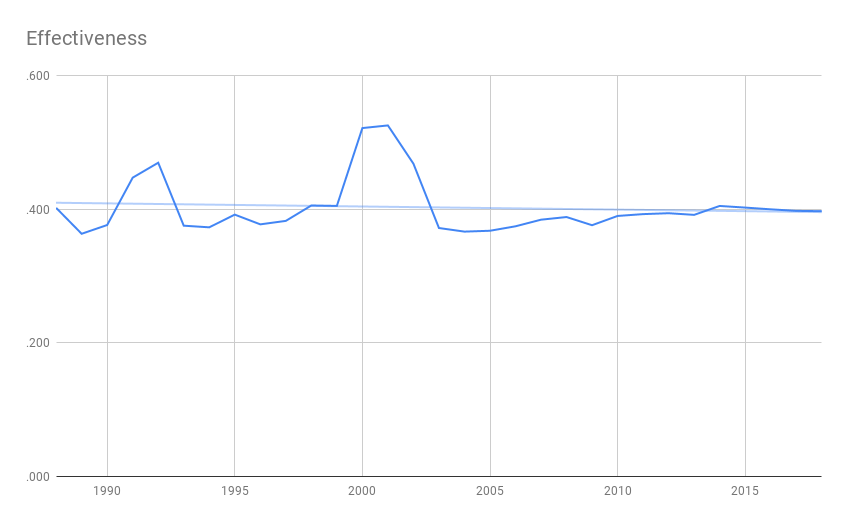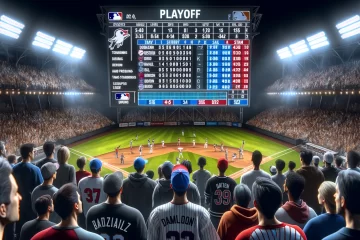With more frequent and more extreme shifts appearing every season, I see lefty batters pull the ball right into someone’s glove while the 3B bag sits there, sad and alone. I keep asking myself… Why don’t players bunt into the shift? It seems to me that if players could effectively bunt down the 3B line when there is no third baseman, shifts would disappear, but it rarely happens. Why not?
a) Because bunting is hard?
b) Because players are arrogant and greedy and want the money that comes with home runs?
c) Because players think their odds are better if they don’t modify their approach just swing naturally?
d) Because managers are afraid of doing anything out of the ordinary for fear of it not working and putting their jobs at risk?
e) Because it’s “bush league” and there are unwritten rules against it?
Let’s look at the numbers. Here’s a yearly breakdown of bunting in recent years:
| Season | Games | Attempts | Hits | Effectiveness
(Batting average on bunt attempts, not including successful sacrifices)
|
Frequency
(Bunt attempts, not including successful sacrifices, per game)
|
|---|---|---|---|---|---|
| 1988 | 4200 | 1503 | 604 | .402 | 0.36 |
| 1989 | 4212 | 1666 | 605 | .363 | 0.40 |
| 1990 | 4210 | 1430 | 538 | .376 | 0.34 |
| 1991 | 4208 | 1490 | 666 | .447 | 0.35 |
| 1992 | 4212 | 1481 | 695 | .469 | 0.35 |
| 1993 | 4538 | 1631 | 612 | .375 | 0.36 |
| 1994 | 3200 | 1073 | 400 | .373 | 0.34 |
| 1995 | 4034 | 1358 | 532 | .392 | 0.34 |
| 1996 | 4534 | 1405 | 530 | .377 | 0.31 |
| 1997 | 4532 | 1318 | 504 | .382 | 0.29 |
| 1998 | 4864 | 1369 | 555 | .405 | 0.28 |
| 1999 | 4856 | 1423 | 576 | .405 | 0.29 |
| 2000 | 4858 | 902 | 470 | .521 | 0.19 |
| 2001 | 4858 | 1080 | 567 | .525 | 0.22 |
| 2002 | 4852 | 1338 | 626 | .468 | 0.28 |
| 2003 | 4860 | 1692 | 629 | .372 | 0.35 |
| 2004 | 4856 | 1594 | 584 | .366 | 0.33 |
| 2005 | 4862 | 1583 | 582 | .368 | 0.33 |
| 2006 | 4858 | 1456 | 545 | .374 | 0.30 |
| 2007 | 4862 | 1429 | 549 | .384 | 0.29 |
| 2008 | 4856 | 1435 | 557 | .388 | 0.30 |
| 2009 | 4860 | 1463 | 550 | .376 | 0.30 |
| 2010 | 4860 | 1447 | 564 | .390 | 0.30 |
| 2011 | 4858 | 1549 | 608 | .393 | 0.32 |
| 2012 | 4860 | 1498 | 590 | .394 | 0.31 |
| 2013 | 4862 | 1349 | 528 | .391 | 0.28 |
| 2014 | 4860 | 1401 | 567 | .405 | 0.29 |
| 2015 | 4858 | 1320 | 531 | .402 | 0.27 |
| 2016 | 4856 | 1211 | 484 | .400 | 0.25 |
| 2017 | 4860 | 1057 | 420 | .397 | 0.22 |
| 2018 | 4862 | 1111 | 441 | .397 | 0.23 |
| TOTAL | 143918 | 43062 | 17209 | .400 | 0.30 |
Charting the data over the years:
There’s a blip around 2000-2001 which is really interesting. Around that time, bunts became a lot less frequent but a lot more effective. Probably not a coincidence that these also happen to be the most offensive couple of years in baseball history. Maybe steroid-infused sluggers pushed all the infielders back a bit, making it easier for those who did not hit for power to bunt for a hit?
How about before 1988? I don’t know. This is as far back as the data goes on Baseball Reference. For some perspective, Mickey Mantle bunted for 87 singles in his career, and he would apparently would lay down bunts even with two strikes. Roger Maris bunted for three singles during his 1961 home run chase. But it’s clear that, in recent years, the general trend is that bunting is becoming less and less popular.
Another thing to note is that the overall batting average for bunting is around .400. I bet it’s closer to .800 when 3B is left vacant by a shift.
So here’s my theory… Going back to the deadball era, bunting was a fundamental part of the game. Getting on base and advancing runners was the goal of every batter, and it was the skilled bunters who were the most valuable and respected players in the league. Then livelier baseballs and stronger players brought the home runs, and the home runs brought big money for teams and players. To put the final nail in the coffin, sabermetrics eventually came along and determined that bunting was statistically unfavorable.
Subsequent generations of players were trained more on hitting than bunting, and bunting in the major leagues declined. With little threat of bunting, teams adjusted their defenses accordingly, pushing fielders back and employing shifts to better cover the field for a player swinging away.
We can see today that extreme shifts open up defensive vulnerabilities down the 3B line. I think it’s only a matter of time before players and managers realize the sabermetric potential of exploiting this and bunting comes back into style. Maybe the next generation of players will learn how to bunt and kill the shift.
And maybe this will be a cyclical thing. A generation of players learn to bunt, defenses adjust to make bunting statistically unfavorable, a generation of players stop bunting, defenses adjust to make bunting statistically favorable again, and so on…
When I was taking batting practice in high school, I had to get down 2 successful bunts before I could even start swinging. Maybe we need to bring that back.





0 Comments